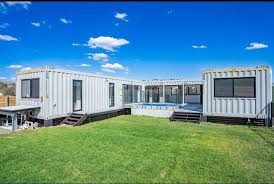The concept of sustainable living has been gaining traction over recent years, with a growing emphasis on reducing our carbon footprint and making more environmentally conscious decisions in our daily lives. One facet of sustainable living that is often discussed is housing. Traditional construction methods are being re-evaluated in favour of greener alternatives to reduce harm to our planet. Within this realm, container homes have emerged as a strong contender in the future of eco-friendly living.
The Appeal of Container Homes
Container homes, as the name suggests, are houses constructed from shipping containers, which have served their primary commercial purpose and would otherwise be left to rust. These containers are re-purposed to create innovative, cost-effective, and environmentally friendly living spaces. The appeal of container homes lies in their inherent strength, durability, and the ease with which they can be transformed into habitable spaces.
The use of these steel boxes in construction presents an avenue for recycling materials that have a significant lifespan. This reuse greatly diminishes the ecological footprint that conventional building materials and methods would have imparted on the environment. Moreover, the modular nature of containers allows for flexibility in design, enabling homeowners to expand or modify their homes with minimal disruption.
Energy Efficiency and Sustainability
A significant aspect of container homes’ popularity is their ability to be energy-efficient. These homes can be easily insulated to a high standard, thereby reducing the need for excessive heating or cooling. The metal structure also lends itself well to the inclusion of solar panels, further decreasing reliance on non-renewable energy sources.
The construction process itself is also often more sustainable compared to traditional building methods. With the primary structure already in place, there is reduced need for new materials, and consequently, there is a reduction in construction waste. Additionally, because container homes can be pre-fabricated, there is less disturbance to the build site, preserving more of the natural surroundings.
Challenges and Considerations
Though container homes are an attractive option for sustainable housing, they are not without challenges. One must consider planning regulations, which can vary widely by location and often are not yet modernised to fully support this type of unconventional housing. Moreover, while the containers themselves are affordable, the cost of outfitting them for residential use can accumulate, depending on the level of comfort and design one desires.
Furthermore, while containers are adept at protecting goods over long sea journeys, when it comes to living spaces, ensuring a comfortable indoor climate can be a challenge. Special attention must be paid to insulation and ventilation to avoid issues with condensation and to maintain a healthy and comfortable living environment.
READ MORE : Transform Your Culinary Space: Top Kitchen Makeovers in Sydney
Design and Aesthetics
One might assume that container homes are somewhat limited in terms of design and aesthetics, but this couldn’t be further from the truth. Architects and designers have been pushing the boundaries of what can be achieved with container construction, creating homes that are not only environmentally friendly, but also visually stunning and fully customisable to individual tastes. The potential for unique and personalised design with container homes is only limited by one’s creativity and budget.
Community and Urban Development
Aside from individual homes, container architecture has been utilised in the creation of communities and urban development projects. From apartment complexes to pop-up shops and communal spaces, container constructions are demonstrating versatility beyond single-family homes. They have been effective in providing quick, affordable, and sustainable solutions to housing crises in various parts of the world.
This modular construction is also increasingly popular in remote areas where transporting traditional building materials is impractical or too expensive. By using containers, which can be transported relatively easily to any location, developers are able to construct in areas previously considered too challenging.
Adaptability and Future Proofing
The conversation about sustainable housing often includes the concept of adaptability and the need for homes to be able to evolve with their owners’ changing needs. Container homes are inherently adaptable; they can be expanded, reduced, reconfigured, and even relocated with relative ease compared to traditional homes. This flexibility lends itself to a future-proofed approach to housing, where the ability to adapt is key to sustainability.
Global Trends and Adoption
Across the globe, the adoption of container homes is on the rise. As more people become conscious of the environmental implications of their choices, the shift towards sustainable housing options is growing. Countries with high shipping traffic are finding innovative uses for the thousands of containers that enter their ports every year, converting what would be waste into viable and vibrant housing solutions.
In light of this global trend, it’s clear that container homes play a crucial role in the conversation around eco-friendly living. As industries and individual consumers alike continue to prioritise sustainability, we can expect to see more of these innovative homes around the world, functioning as a testament to the versatility and potential of recycled materials in architecture.
Conclusion
In conclusion, container homes present a compelling alternative to traditional housing, offering an eco-friendly solution that addresses some of the most pressing environmental concerns of our time. They are not just a trend but represent a shift in how we perceive and value our living spaces, placing sustainability, efficiency, and adaptability at the forefront.
As societies move forward, looking to balance the needs of a growing population with the need to preserve our planet, the innovative use of container homes is likely to play a significant role. This movement towards a more sustainable future symbolises a commitment to responsible living, where every unused container can become a building block for a greener tomorrow.
